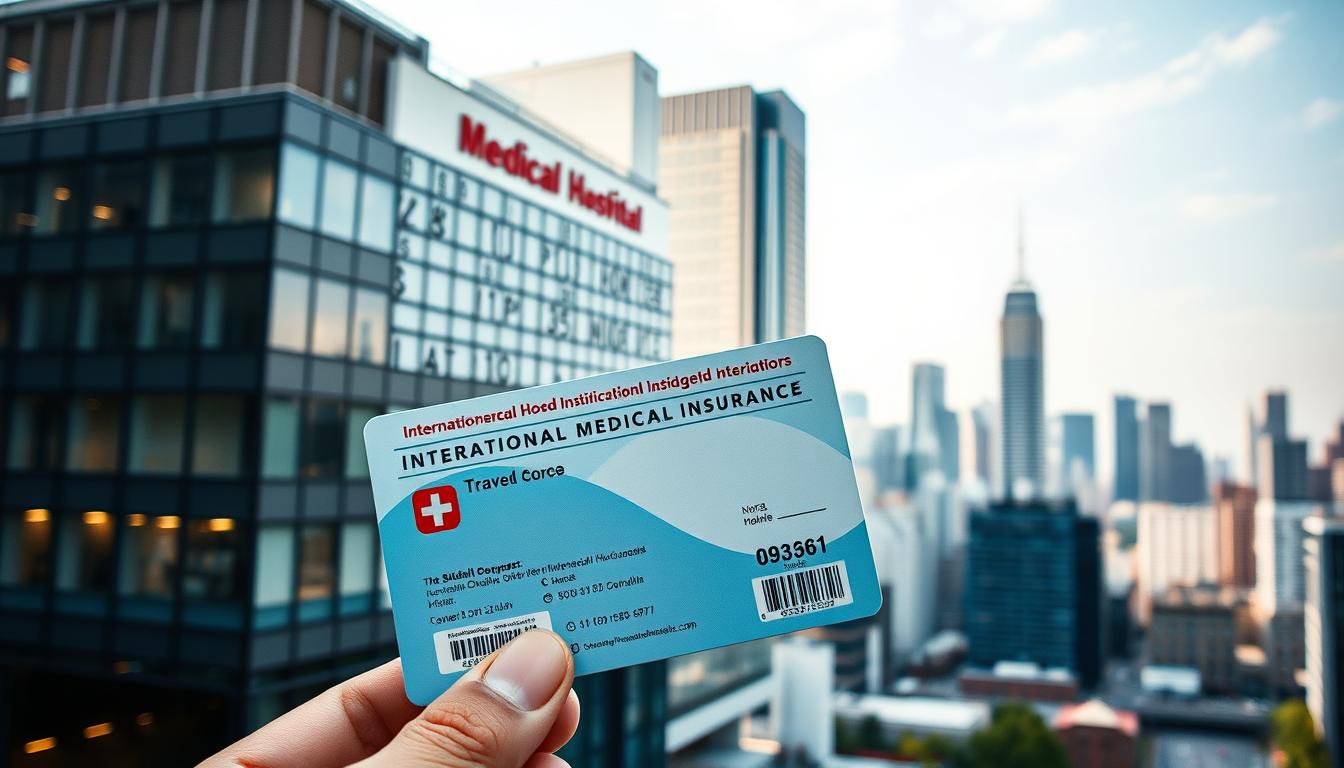What happens if you need urgent care while exploring new destinations? Your regular health plan might not protect you outside the United States. Many travelers discover this reality too late—facing steep bills for emergencies far from home.
This guide helps you avoid that stress. We’ll explain how travel medical insurance bridges gaps left by standard policies. Whether it’s a sudden illness or an unexpected injury, having the right coverage ensures you’re prepared without draining savings.
Domestic plans rarely include international hospital visits. Even routine care can become costly overseas. A specialized policy offers peace of mind with features like emergency evacuation and 24/7 support teams.
Think of this as your roadmap to smarter protection. From comparing plans to understanding fine print, we simplify complex details. Our advice comes from years of helping adventurers stay safe—so you can focus on the journey ahead.
Understanding International Hospital Costs
Medical needs don’t pause for passports—but your wallet might feel the impact. Where you receive care dramatically shapes what you’ll pay. Let’s break down why a broken arm in Berlin costs differently than in Bangkok.
What Shapes Your Bill Overseas?
Three elements decide your expenses: local pricing standards, facility quality, and whether providers work with your plan. Urban clinics often charge more than rural ones, even in the same nation. For example, Tokyo’s central districts have higher fees than Hokkaido’s countryside centers.
Geography Meets Healthcare
Countries structure their systems uniquely. Germany’s regulated fees contrast with Thailand’s flexible private clinics. Check this comparison:
| Country | Average ER Visit | Public vs Private |
|---|---|---|
| Mexico | $200-$500 | Mix |
| France | $150-$300 | Public |
| India | $40-$120 | Private |
Most U.S. health plans lack global networks, leaving you to pay upfront. Specialized coverage bridges this gap, matching care quality with your budget. Always verify if your policy includes direct billing abroad.
Travel Insurance Hospital Costs Abroad: What You Need to Know
Imagine twisting your ankle while hiking in the Alps. Your U.S. health plan might not cover that X-ray or ambulance ride. Domestic policies often exclude out-of-network care abroad, leaving you responsible for bills that could reach thousands.
Bridging the Protection Gap
Specialized medical insurance acts like a safety net. It steps in when your primary coverage stops at the border. For example, Cigna’s international coverage details show how supplemental plans handle expenses your regular policy ignores.
Critical Situations Addressed
These policies focus on urgent scenarios needing immediate attention. Covered events typically include:
- Fractures from slips or falls
- Cardiac events requiring ER visits
- Sudden neurological episodes like strokes
- Emergency dental repairs for accidents
Delaying treatment until you return home often worsens outcomes. Quality care abroad prevents complications while reducing recovery time. Many plans also offer translation services to help navigate unfamiliar healthcare systems.
Choosing the right supplemental coverage means comparing what’s included versus excluded. Look for policies specifying direct payments to overseas facilities – this avoids draining your savings during crises.
Comprehensive vs. Medical-Specific Insurance Plans
Choosing the right protection for your journey means understanding two main options. Comprehensive policies bundle medical care with trip-related safeguards, while medical-specific plans focus solely on health emergencies. Let’s explore which fits your adventure best.

Benefits and Limitations of Each Plan Type
Comprehensive plans act like Swiss Army knives. They typically include trip cancellation reimbursement, lost luggage coverage, and emergency care. However, they might exclude specialized treatments or limit payouts for high-risk activities like skiing.
Medical-specific policies dive deep into health crises. These often cover hospital stays, prescription medications, and emergency evacuations. But they won’t reimburse canceled flights or stolen cameras. The CDC Yellow Book recommends these for travelers prioritizing health over trip logistics.
Coverage Considerations for Pre-existing Conditions
Many policies exclude chronic illnesses unless you meet specific criteria. Some insurers require a stability period—like 60-180 days without treatment changes—before approving coverage. Always request a waiver in writing if needed.
For example, a diabetes patient might need proof of stable blood sugar levels before departure. Review policy fine print carefully: terms vary widely between providers. We’ve seen cases where clarity upfront prevented claim denials later.
Evaluating Insurance Policies and Providers for International Travel
Navigating international healthcare systems can feel overwhelming without the right safety net. Choosing coverage that matches your needs requires understanding what separates reliable plans from inadequate ones.
Key Policy Features to Look For
24/7 emergency assistance tops the list. Providers like Travel Insured International connect you with local care instantly—no time zone math required. Look for these essentials:
- Direct billing agreements with global hospitals
- Clear definitions of covered emergencies (sudden illnesses vs. chronic conditions)
- Step-by-step claim instructions with online submission options
Always review policy exclusions thoroughly. Some plans exclude high-risk activities like scuba diving unless you purchase add-ons. Pre-authorization requirements matter too—certain treatments need approval before proceeding.
Reputable companies simplify comparisons through:
- Transparent expense limits per incident
- Multilingual support teams
- Online provider directories for in-network facilities
One traveler we assisted avoided $8,000 in out-of-pocket costs because their plan handled payments directly with a Paris clinic. That’s the power of strategic preparation.
Understanding Additional Insurance Benefits Abroad
When unexpected health issues arise overseas, quality policies offer more than just bill coverage. Let’s explore critical benefits that transform stressful situations into manageable ones.
When Every Second Counts
Emergency medical evacuation ensures you reach proper care swiftly. Imagine needing a helicopter from a remote mountain trail or an air ambulance between countries. These services often exceed $100,000—but robust plans cover 100%.
Repatriation handles returning remains home if the worst occurs. Without this coverage, families face complex logistics and steep fees during unimaginable grief.
Your Global Support Team
Navigating foreign clinics becomes easier with 24/7 assistance. Many providers connect you with translators via phone within minutes. They’ll also explain local payment processes and help complete paperwork.
Some policies let you choose preferred facilities when possible. One client avoided misdiagnosis in Lima by using this feature to reach a bilingual cardiologist.
These extras matter because crises strain both budgets and emotions. Comprehensive plans handle logistics so you can focus on recovery. Always verify evacuation limits and service response times before departure.
Planning Your Trip with a Focus on Health and Insurance Protection
Smart adventurers know preparation is key to worry-free exploration. Before packing your bags, create a financial safety net for potential health surprises. Let’s simplify how to balance excitement with practical safeguards.
Budgeting for Unexpected Medical Costs
Start by setting aside an emergency fund equal to 5-10% of your trip budget. This covers deductibles or care not fully covered by your plan. Most policies cost just 4-8% of your total expenses—far less than paying out-of-pocket for a single ER visit.
Compare these examples:
| Country | Average Insurance Cost* | Potential Out-of-Pocket Expense |
|---|---|---|
| Mexico | $45-$90 | $2,500+ (broken arm) |
| France | $70-$130 | $4,000+ (severe allergic reaction) |
| India | $30-$60 | $1,200+ (food poisoning hospitalization) |
*For 2-week trip | Source: Market rate analysis
Always check two details in policy documents: maximum coverage limits (aim for $100,000+) and deductible amounts. Lower deductibles mean higher premiums—choose based on your risk tolerance.
We recommend allocating funds specifically for medical emergencies and policy premiums. This approach lets you enjoy new cultures without financial anxiety. Remember, preparedness isn’t about expecting the worst—it’s about embracing adventures with confidence.
Conclusion
Your passport opens doors to new experiences—but unexpected health issues can slam them shut. Domestic health insurance rarely stretches across borders, leaving you vulnerable to steep bills and logistical nightmares.
A robust medical insurance policy transforms crisis into manageable solutions. Whether it’s emergency evacuation or multilingual support teams, specialized plans address gaps your regular coverage ignores. Comprehensive options bundle trip protections, while medical-focused versions prioritize urgent care without distractions.
Review plan specifics carefully—what’s excluded often matters more than what’s included. Budget for deductibles and verify maximum payout limits. We’ve seen travelers breathe easier knowing their chosen coverage handles direct payments to overseas clinics.
Use this guide as your compass for navigating policy comparisons. Prioritize 24/7 assistance networks and clear claim processes. With thoughtful preparation, you’ll trade anxiety for confidence—freeing you to savor every moment of your global adventures.


